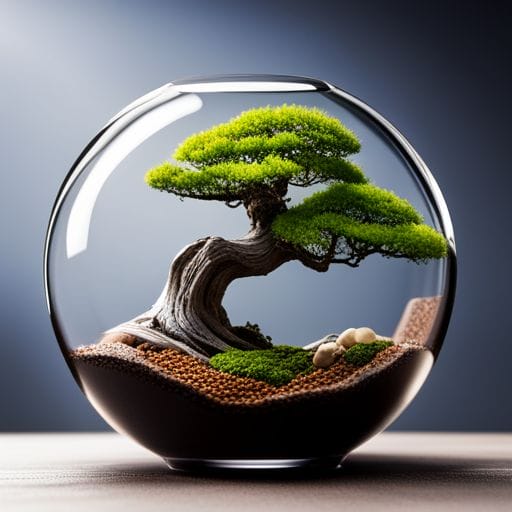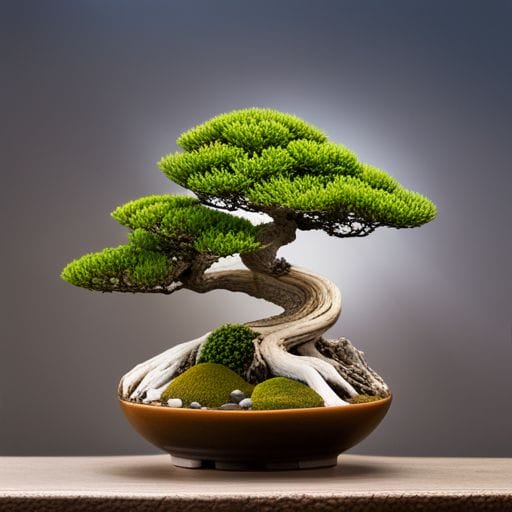Bonsai terrariums, a type of closed terrarium, offer an enchanting way to bring miniature trees into our living spaces. These terrariums, made using delicate bonsai trees, create captivating miniature worlds that are both visually appealing and self-contained environments for plants, animals, and people.
With their intricate features, bonsai trees are well-suited for terrariums, providing a unique opportunity to appreciate their beauty up close. When choosing a bonsai tree for a terrarium, factors such as size, shape, soil needs, light requirements, and water needs should be carefully considered.
Suitable bonsai tree species for terrariums include bald cypress, bougainvillea, Brazilian rain tree, ficus, fukien tea, and water jasmine. By selecting the right bonsai tree and following proper care tips, bonsai terrariums can be easily maintained and enjoyed for years to come.
Contents
- 1 Quick Points
- 2 What are they?
- 3 Suitable Species
- 4 Terrarium Care Tips
- 5 Frequently Asked Questions
- 5.1 Can any type of bonsai tree be used in a terrarium, or are there specific species that are more suitable?
- 5.2 How often should a bonsai tree in a terrarium be watered?
- 5.3 Are there any specific pests or diseases that bonsai trees in terrariums are prone to?
- 5.4 Can bonsai trees in terrariums be placed outdoors, or should they always be kept indoors?
- 5.5 Is it possible to create a bonsai terrarium with multiple trees, or should it only contain one tree?
Quick Points
- Bonsai terrariums are miniature worlds created using bonsai trees.
- Terrariums are closed transparent containers used to grow miniature trees.
- Terrariums can be simple glass jars or elaborate structures imitating natural landscapes.
– Bonsai trees in terrariums thrive indoors with sufficient sunlight, but a grow light can be used if natural light is limited.
What are they?

Bonsai terrariums, which are miniature worlds created using bonsai trees, provide a self-contained environment for plants, animals, and people, making them suitable for small spaces or individuals with limited time for plant care. These terrariums are closed transparent containers that allow for the growth of miniature trees. They can be simple glass jars or elaborate structures imitating natural landscapes.
There are two types of terrariums: open and closed. Open terrariums allow for better airflow and drainage, while closed terrariums are ideal for plants that prefer high humidity and less air circulation.
Bonsai trees in terrariums have benefits such as reduced watering needs and the ability to create a miniature garden in a small space. They require specific items like clear glass vessels, small rocks, activated charcoal, peat or sphagnum moss, potting soil, a small spade or trowel, a mist bottle, and a bonsai tree.
Suitable Species

When considering suitable species for a bonsai terrarium, it is important to evaluate various factors such as tree size, growth pattern, and foliage color.
Here are some species that are well-suited for bonsai terrariums:
- Bald Cypress: This tree has a slender and elegant growth pattern, making it ideal for small spaces. Its vibrant green foliage adds a refreshing touch to the terrarium.
- Bougainvillea: Known for its colorful and eye-catching flowers, the Bougainvillea is a popular choice for bonsai terrariums. It can be trained to create unique shapes and its compact size is perfect for miniature landscapes.
- Brazilian Rain Tree: With delicate fern-like foliage and a graceful growth habit, the Brazilian Rain Tree adds a touch of exotic beauty to the terrarium. It thrives in high humidity environments.
- Ficus: The Ficus bonsai is a versatile choice for terrariums, as it comes in various sizes and foliage colors. Its glossy leaves and aerial roots create a captivating visual appeal.
- Fukien Tea: This tree features small, dark green leaves and produces tiny white flowers. Its compact size and the ability to withstand indoor conditions make it an excellent choice for terrariums.
- Water Jasmine: With its small, star-shaped white flowers and glossy foliage, the Water Jasmine adds a touch of elegance to the terrarium. It requires high humidity and indirect light.
These species provide a range of options for creating a beautiful and captivating bonsai terrarium. Consider their unique characteristics and requirements when making your selection.
Terrarium Care Tips

Terrarium care involves proper maintenance and attention to ensure the health and longevity of the enclosed ecosystem. To effectively care for a bonsai terrarium, there are several key tips to keep in mind.
Firstly, watering is crucial. Bonsai trees in terrariums should be watered daily, saturating the top layer of soil with a mist bottle or spray bottle. This helps to maintain the necessary moisture levels for the plants to thrive.
Secondly, lighting is important. Bonsai trees require sufficient sunlight, so placing the terrarium in a location that receives adequate natural light is ideal. In cases where natural light is limited, a grow light can be used to supplement the lighting needs.
Lastly, temperature control is essential. Extreme temperatures should be avoided, and during winter, wrapping the terrarium can help keep it warm. Additionally, using Akadama soil, which has good drainage and water retention properties, can contribute to the overall health of the bonsai tree and the terrarium ecosystem.
By following these care tips, bonsai terrariums can provide years of enjoyment and serve as a beautiful addition to any space.
| Care Tips | Description |
|---|---|
| Watering | Water bonsai trees daily, saturating the top layer of soil with a mist bottle or spray bottle. |
| Lighting | Place the terrarium in a location with sufficient natural light; consider using a grow light if natural light is limited. |
| Temperature Control | Avoid extreme temperatures and wrap the terrarium during winter to keep it warm. |
| Akadama Soil | Use Akadama soil, which has good drainage and water retention properties, to promote the health of the bonsai tree and the terrarium ecosystem. |
Frequently Asked Questions
Can any type of bonsai tree be used in a terrarium, or are there specific species that are more suitable?
Specific species of bonsai trees are more suitable for terrariums due to their ability to thrive in a closed environment with high humidity and limited air circulation. Examples include bald cypress, bougainvillea, Brazilian rain tree, ficus, fukien tea, and water jasmine.
How often should a bonsai tree in a terrarium be watered?
A bonsai tree in a terrarium should be watered daily, saturating the top layer of soil with a mist or spray bottle. This helps maintain the necessary moisture levels for the bonsai tree’s growth and survival.
Are there any specific pests or diseases that bonsai trees in terrariums are prone to?
Bonsai trees in terrariums are generally not prone to specific pests or diseases. However, occasional issues such as spider mites, mealybugs, and mold due to high humidity may occur. These can be treated by removing pests and using appropriate solutions.
Can bonsai trees in terrariums be placed outdoors, or should they always be kept indoors?
Bonsai trees in terrariums are typically kept indoors to provide optimal environmental conditions. While they can withstand some outdoor exposure, the controlled environment of an indoor terrarium ensures consistent temperature, humidity, and light levels for their delicate nature.
Is it possible to create a bonsai terrarium with multiple trees, or should it only contain one tree?
It is possible to create a bonsai terrarium with multiple trees, but it is important to consider the space available and the specific needs of each tree. Proper planning and maintenance are necessary to ensure the health and aesthetics of the terrarium.




